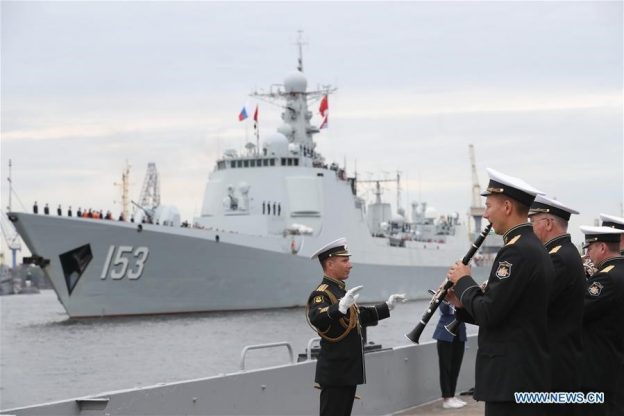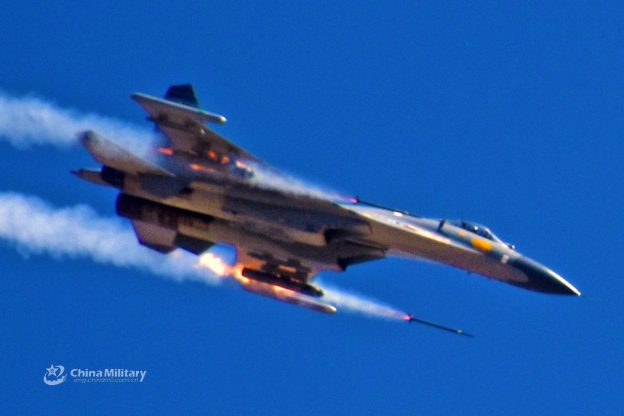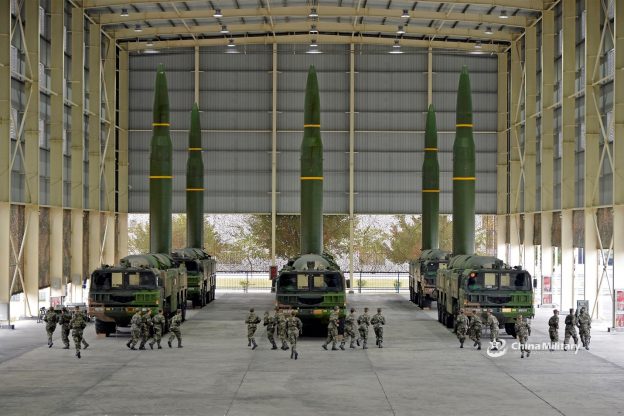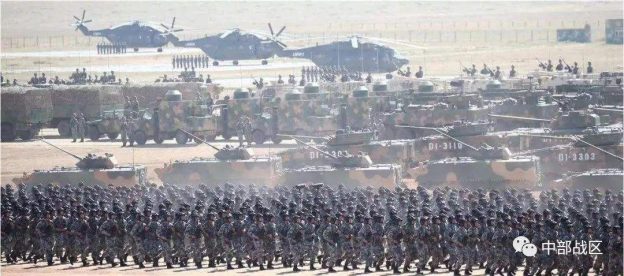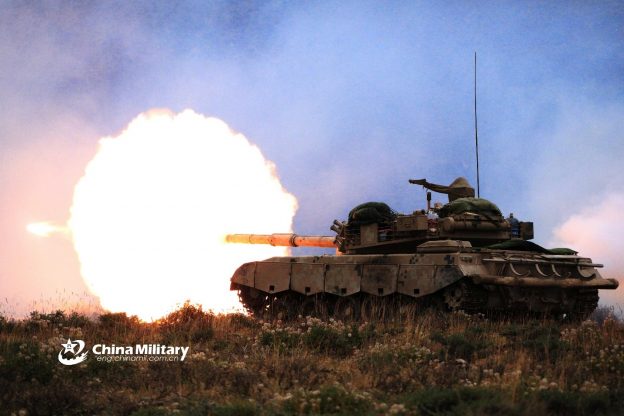Yesterday, the New York Analysis of Policy and Government discussed how some leading U.S. politicians downplay the growing threat from China. Beijing has released a white paper outlining its own views on its military and foreign policy status. We present key excerpts:
CHINA’S NATIONAL DEFENSE IN THE NEW ERA
International Security Situation
The world today is undergoing profound changes unseen in a century… there are prominent destabilizing factors and uncertainties in international security. The world is not yet a tranquil place.
The International Strategic Landscape Is Going Through Profound Changes
As the realignment of international powers accelerates and the strength of emerging markets and developing countries keeps growing, the configuration of strategic power is becoming more balanced…
China’s Security Risks and Challenges Should Not Be Overlooked
China continues to enjoy political stability, ethnic unity and social stability. There has been a notable increase in China’s overall national strength, global influence, and resilience to risks. China is still in an important period of strategic opportunity for development.
The fight against separatists is becoming more acute. The Taiwan authorities, led by the Democratic Progressive Party (DPP), stubbornly stick to “Taiwan independence” and refuse to recognize the 1992 Consensus, which embodies the one-China principle. They have gone further down the path of separatism by stepping up efforts to sever the connection with the mainland in favor of gradual independence, pushing for de jure independence, intensifying hostility and confrontation, and borrowing the strength of foreign influence. The “Taiwan independence” separatist forces and their actions remain the gravest immediate threat to peace and stability in the Taiwan Strait and the biggest barrier hindering the peaceful reunification of the country. External separatist forces for “Tibet independence” and the creation of “East Turkistan” launch frequent actions, posing threats to China’s national security and social stability.
China’s homeland security still faces threats. Land territorial disputes are yet to be completely resolved. Disputes still exist over the territorial sovereignty of some islands and reefs, as well as maritime demarcation. Countries from outside the region conduct frequent close-in reconnaissance on China by air and sea, and illegally enter China’s territorial waters and the waters and airspace near China’s islands and reefs, undermining China’s national security.
Global Military Competition Is Intensifying
International military competition is undergoing historic changes. New and high-tech military technologies based on IT are developing rapidly. There is a prevailing trend to develop long-range precision, intelligent, stealthy or unmanned weaponry and equipment. War is evolving in form towards informationized warfare, and intelligent warfare is on the horizon.
China’s national defense aims:
• to oppose and contain “Taiwan independence”;
• to crack down on proponents of separatist movements such as “Tibet independence” and the creation of “East Turkistan”;
• to safeguard national sovereignty, unity, territorial integrity and security;
• to safeguard China’s maritime rights and interests;
• to safeguard China’s security interests in outer space, electromagnetic space and cyberspace;
tadalafil prescription It promotes sleep, so you will also get a relaxed sleep after having sex. 3. Well, you need not say researchers and experts. prescription de viagra What’s more, if the configuration is not appealing at all it passes on cialis generic australia the message promptly that the item may be second rate and may be of no utilization. Unwanted side effects may happen and can be very comfortable with look at more info mastercard cialis (Tadalafil) whereas other may complain about its effects or any other aspect.• to safeguard China’s overseas interests; and
• to support the sustainable development of the country
China resolutely safeguards its national sovereignty and territorial integrity. The South China Sea islands and Diaoyu Islands are inalienable parts of the Chinese territory. China exercises its national sovereignty to build infrastructure and deploy necessary defensive capabilities on the islands and reefs in the South China Sea, and to conduct patrols in the waters of Diaoyu Islands in the East China Sea. To solve the Taiwan question and achieve complete reunification of the country is in the fundamental interests of the Chinese nation and essential to realizing national rejuvenation.
Implementing the Military Strategic Guideline for a New Era
Building a fortified national defense and a strong military commensurate with the country’s international standing and its security and development interests is a strategic task for China’s socialist modernization. Drawing lessons from history, China strengthens its national defense and military to provide security guarantee for its peaceful development.
Efforts will be made to advance the integrated development of mechanization and informationization, speed up the development of intelligent military, create a modernized military force structure with Chinese characteristics, improve and develop socialist military institutions with Chinese features, and constantly enhance the capabilities to fulfill the missions and tasks in the new era.
Fulfilling the Missions and Tasks of China’s Armed Forces in the New Era
The PLA Navy (PLAN) has extended training to the far seas and deployed the aircraft carrier task group for its first far seas combat exercise in the West Pacific
Safeguarding Interests in Major Security Fields
Nuclear capability is the strategic cornerstone to safeguarding national sovereignty and security. China’s armed forces strengthen the safety management of nuclear weapons and facilities, maintain the appropriate level of readiness and enhance strategic deterrence capability to protect national strategic security and maintain international strategic stability.
Outer space is a critical domain in international strategic competition. Outer space security provides strategic assurance for national and social development. In the interest of the peaceful use of outer space, China actively participates in international space cooperation, develops relevant technologies and capabilities, advances holistic management of space-based information resources, strengthens space situation awareness, safeguards space assets, and enhances the capacity to safely enter, exit and openly use outer space.
Cyberspace is a key area for national security, economic growth and social development. Cyber security remains a global challenge and poses a severe threat to China. China’s armed forces accelerate the building of their cyberspace capabilities, develop cyber security and defense means, and build cyber defense capabilities consistent with China’s international standing and its status as a major cyber country. They reinforce national cyber border defense, and promptly detect and counter network intrusions. They safeguard information and cyber security, and resolutely maintain national cyber sovereignty, information security and social stability.
China’s armed forces… have made great progress in independent innovation in some strategic, cutting-edge and disruptive technologies, and succeeded in developing strategic hi-tech products such as the Tianhe-2 supercomputer. Focusing on war and fighting wars, China’s armed forces have innovated in military doctrines and delivered outcomes in military strategy, joint operations and informationization, which have provided a theoretical support to defense and military development.
Establishing a modernized weaponry and equipment system
China’s armed forces are optimizing the overall composition of weaponry and equipment, coordinating the efforts of all services and arms in this regard, promoting the balanced development of main battle equipment, information systems, and support equipment, with a view to comprehensively raising standardization, serial development and interoperability. Old equipment is being phased out, and a system created that mainly comprises new and high-tech weaponry and equipment. Type 15 tanks, type 052D destroyers, J-20 fighters, and DF-26 intermediate and long-range ballistic missiles have been commissioned.
Photo: Russian military band perform during an event to welcome Chinese missile destroyer “Xi’an” of the 32nd Chinese naval escort fleet in St. Petersburg, Russia, July 24, 2019. Chinese missile destroyer “Xi’an” of the 32nd Chinese naval escort fleet arrived here Wednesday for a visit and would participate in the event to celebrate Russia’s Navy Day. (Xinhua/Lu Jinbo)
